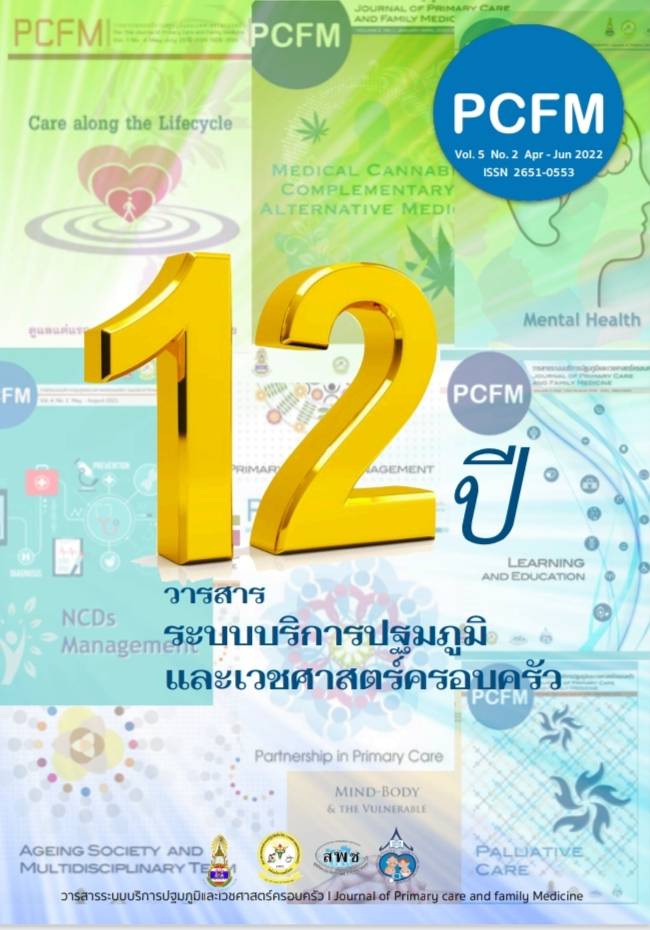ผลการควบคุมระดับน้ำตาลของผู้ป่วยเบาหวานชนิดที่ 2 จากการได้รับความรู้ผ่านแอปพลิเคชันไลน์ ณ โรงพยาบาล ท่าวุ้ง จังหวัดลพบุรี
Main Article Content
บทคัดย่อ
บทคัดย่อ
วัตถุประสงค์: เพื่อศึกษาผลการควบคุมระดับน้ำตาลของผู้ป่วยเบาหวานชนิดที่ 2 จากการได้รับความรู้ผ่านแอปพลิเคชันไลน์เปรียบเทียบกับการให้ความรู้แบบปกติ โรงพยาบาลท่าวุ้ง จังหวัดลพบุรี
แบบวิจัย: Non-randomized control trial
วัสดุและวิธีการ: แบ่งผู้ป่วยที่เข้าร่วมวิจัยตั้งแต่วันที่ 1 ถึง 30 เมษายน 2564 ออกเป็น 2 กลุ่ม คือ กลุ่มผู้ป่วยที่ได้รับความรู้ตามมาตรฐาน DSME ร่วมกับการเข้ากลุ่มไลน์ (กลุ่มศึกษา) และกลุ่มผู้ป่วยที่ได้รับความรู้ตามมาตรฐาน DSME เพียงอย่างเดียว (กลุ่มเปรียบเทียบ) และติดตามผลการรักษาเป็นระดับ HbA1C และ FBS ที่ระยะเวลา 6 เดือน นำข้อมูลที่ได้มาวิเคราะห์ความสัมพันธ์โดยใช้สถิติ Gaussian regression
ผลการศึกษา: ผู้เข้าร่วมวิจัยทั้งหมด 40 คน แบ่งเป็นกลุ่มศึกษา 20 คน และกลุ่มเปรียบเทียบ 20 คน ซึ่งลักษณะทั่วไปของทั้งสองกลุ่มเหมือนกัน ยกเว้นอายุและความดันเลือดขณะหัวใจคลายตัว พบว่าเมื่อครบ 6 เดือน ระดับ HbA1C ของกลุ่มศึกษามีค่าน้อยกว่ากลุ่มเปรียบเทียบ 0.10 (95% CI: -1.23-1.02, p-value 0.858) และระดับ FBS กลุ่มศึกษามีค่าน้อยกว่ากลุ่มเปรียบเทียบ 2.44 ไม่แตกต่างกันทางสถิติ (95% CI: -28.07-23.02, p-value 0.852)
สรุป: ผู้ป่วยเบาหวานชนิดที่ 2 ที่ได้รับความรู้ตามมาตรฐาน DSME ร่วมกับการเข้าร่วมกลุ่มไลน์สามารถลดระดับน้ำตาลสะสมในเลือดมากกว่ากลุ่มที่ไม่ได้เข้าร่วมกลุ่มไลน์ไม่แตกต่างกันทางสถิติ
คำสำคัญ: ระดับน้ำตาลสะสม, ผู้ป่วยเบาหวานชนิดที่ 2, การดูแลโรคเบาหวานด้วยตนเอง
Article Details

อนุญาตภายใต้เงื่อนไข Creative Commons Attribution-NonCommercial-NoDerivatives 4.0 International License.
เนื้อหาและข้อมูลในบทความที่ลงตีพิมพ์ในวารสาร PCFM ถือเป็นข้อคิดเห็นและความรับผิดชอบของผู้เขียนบทความโดยตรง ซึ่งกองบรรณาธิการวารสารไม่จำเป็นต้องเห็นด้วยหรือร่วมรับผิดชอบใด ๆ
บทความ ข้อมูล เนื้อหา รูปภาพ ฯลฯ ที่ได้รับการตีพิมพ์ลงในวารสาร PCFM ถือเป็นลิขสิทธิ์ของวารสาร PCFM หากบุคคลหรือหน่วยงานใดต้องการนำทั้งหมดหรือส่วนหนึ่งส่วนใดไปเผยแพร่ต่อหรือเพื่อกระทำการใด ๆ จะต้องได้รับอนุญาตเป็นลายลักษณ์อักษรจากวารสาร PCFM ก่อนเท่านั้น
เอกสารอ้างอิง
International Diabetes Federation. Worldwide toll of diabetes [Internet]. 2021 [cited 2021 Feb 18].
Available from: https://www.diabetesatlas.org/en/sections/worldwide-toll-of-diabetes.html
สมาคมโรคเบาหวานแห่งประเทศไทย. สถานการณ์โรคเบาหวาน [อินเทอร์เน็ต]. 2560 [เข้าถึงเมื่อ 18 กุมภาพันธ์ 2564]. เข้าถึงได้จาก: https://www.dmthai.org/index.php/knowledge/the-chart/the-chart-1/549-2018-02-08-14-52-46
วิชัย เอกพลากร. บทนำ. ใน: วิชัย เอกพลากร, บรรณาธิการ. รายงานการสำรวจสุขภาพประชาชนไทย โดยการตรวจร่างกาย ครั้งที่ 5 พ.ศ.2557. นนทบุรี: สถาบันวิจัยระบบสาธารณสุข; 2559: 5-6
Hathaikan Honghrajok. ดารให้ความรู้แก่ผู้ป่วยในการดูแลตนเอง [อินเทอร์เน็ต]. 2555 [เข้าถึงเมื่อ 18 กุมภาพันธ์ 2564]. เข้าถึงได้จาก: https://www.gotoknow.org/posts/376503
วิโรจน์ เจียมจรัสรังษี. กรอบแนวคิดการสนับสนุนการจัดการดูแลตนเองในคลินิกสำหรับผู้ป่วยโรคเบาหวานชนิดที่ 2.
จุฬาลงกรณ์เวชสาร. 2556; 57(3): 279–91.
ระดับน้ำตาลสะสมที่ดีควรเป็นเท่าใด [อินเทอร์เน็ต]. [เข้าถึงเมื่อ 18 กุมภาพันธ์ 2564]. เข้าถึงได้จาก:
https://www.siamhealth.net/public_html/Disease/endocrine/DM/complication2.html
Telemedicine คือ อะไร [อินเทอร์เน็ต]. 2562 [เข้าถึงเมื่อ 27 กุมภาพันธ์ 2564]. เข้าถึงได้จาก:
https://allwellhealthcare.com/telemedicine/
พิมพ์ใจ อันทานนท์. โรคเบาหวาน คืออะไร [อินเทอร์เน็ต]. 2564 [เข้าถึงเมื่อ 18 กุมภาพันธ์ 2564]. เข้าถึงได้จาก: https://www.dmthai.org/index.php/knowledge/for-normal-person/health-information-and-articles/health-information-and-articles-old-3/846-2019-04-20-01-49-18
Alotaibi MM, Istepanian R, Philip N. A mobile diabetes management and educational system for type-2 diabetics in Saudi Arabia (SAED). mHealth 2016; 2(33): 29-36.
Ji Yun J, Jae-Han J, Kwi-Hyun B, Yeon-Kyung Ch, Keun-Gyu P, Jung-Guk K, et al. Smart Care Based on Telemonitoring and Telemedicine for Type 2 Diabetes Care: Multi-Center Randomized Controlled Trial. Telemed e-Health 2018; 24(8): 604-13.
Yonghui D, Ping W, Zhipeng D, Ke L, Yi J, Ang L, et al. Increased self-care activities and glycemic control rate in relation to health education via Wechat among diabetes patients: A randomized clinical trial. Medicine 2018; 97(50): e132-e136.
Harashima S, Nishimura A, Ikeda K, Wang Y, Liu Y, Inagaki N. Once Daily Self-Monitoring of Blood Glucose (SMBG) Improves Glycemic Control in Oral Hypoglycemic Agents (OHA)–Treated Diabetes: SMBG-OHA Follow-Up Study. Journal of Diabetes Science and Technology 2015; 10(2): 378-382. doi:10.1177/1932296815608869
Young L. A, Buse J. B, Weaver M. A, Vu M. B, Mitchell C. M., Blakeney T, et al. Glucose Self-monitoring in Non–Insulin-Treated Patients With Type 2 Diabetes in Primary Care Settings. JAMA Internal Medicine 2017; 177(7), 920-9. doi:10.1001/jamainternmed.2017.1233
Sood A, Watts S. A, Johnson J. K, Hirth S, Aron D. C. Telemedicine consultation for patients with diabetes mellitus: a cluster randomised controlled trial. Journal of Telemedicine and Telecare 2017; 24(6), 385–91. doi:10.1177/1357633x17704346
Banerjee M, Chakraborty S, Pal R. Diabetes self-management amid COVID-19 pandemic. Diabetes & Metabolic Syndrome: Clinical Research & Reviews 2020; 14, 351-4. doi:10.1016/j.dsx.2020.04.013
Mukona D. M, Zvinavashe M. Self- management of diabetes mellitus during the Covid-19 pandemic: Recommendations for a resource limited setting. Diabetes & Metabolic Syndrome: Clinical Research & Reviews 2020; 14(6), 1575–8. doi:10.1016/j.dsx.2020.08.022


